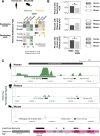This is a preprint.
CpG island turnover events predict evolutionary changes in enhancer activity
- PMID: 37214934
- PMCID: PMC10197647
- DOI: 10.1101/2023.05.09.540063
CpG island turnover events predict evolutionary changes in enhancer activity
Update in
-
CpG island turnover events predict evolutionary changes in enhancer activity.Genome Biol. 2024 Jun 13;25(1):156. doi: 10.1186/s13059-024-03300-z. Genome Biol. 2024. PMID: 38872220 Free PMC article.
Abstract
Genetic changes that modify the function of transcriptional enhancers have been linked to the evolution of biological diversity across species. Multiple studies have focused on the role of nucleotide substitutions, transposition, and insertions and deletions in altering enhancer function. Here we show that turnover of CpG islands (CGIs), which contribute to enhancer activation, is broadly associated with changes in enhancer activity across mammals, including humans. We integrated maps of CGIs and enhancer activity-associated histone modifications obtained from multiple tissues in nine mammalian species and found that CGI content in enhancers was strongly associated with increased histone modification levels. CGIs showed widespread turnover across species and species-specific CGIs were strongly enriched for enhancers exhibiting species-specific activity across all tissues and species we examined. Genes associated with enhancers with species-specific CGIs showed concordant biases in their expression, supporting that CGI turnover contributes to gene regulatory innovation. Our results also implicate CGI turnover in the evolution of Human Gain Enhancers (HGEs), which show increased activity in human embryonic development and may have contributed to the evolution of uniquely human traits. Using a humanized mouse model, we show that a highly conserved HGE with a large CGI absent from the mouse ortholog shows increased activity at the human CGI in the humanized mouse diencephalon. Collectively, our results point to CGI turnover as a mechanism driving gene regulatory changes potentially underlying trait evolution in mammals.
Figures








References
-
- Reilly S. K., Noonan J. P., Evolution of Gene Regulation in Humans. Annu Rev Genom Hum G 17, annurev-genom-090314–045935 (2016). - PubMed
Publication types
Grants and funding
LinkOut - more resources
Full Text Sources
Molecular Biology Databases
